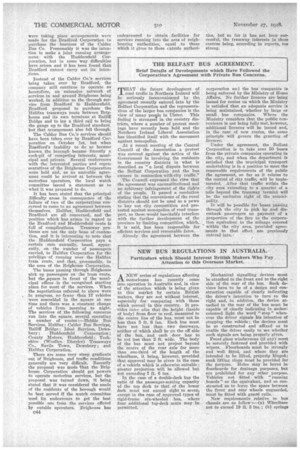NEW BUS REGULATIONS IN AUSTRALIA.
Page 28

Page 29

If you've noticed an error in this article please click here to report it so we can fix it.
Particulars which Should Interest British Makers Who Fay Attention to this Overseas Market.
NEW seriesseries of regulations affecting motorbuses has recently come into operation in Australia and, in view of the attention which is beine-' given to this market by certain British makers, they are not without interest,_ especially for comparing with those which prevail in this country. It provides ink?' alia that the height (inside of body) from floor to roof, measured to the centre line of the bus, must not be less than 5 ft. 6 ins. Each bus must have not less than two doorways, neither of which shall be on the off side of the bus, and each door has to be not less than 2 ft. wide. The body of the bus must not project beyond the centre of the rear axle for more than one-third of the length of the wheelbase, it being, however, provided that approval may be given in the case of a vehicle which is otherwise suitable; greater projection will be allowed but not exceeding 7 ft. 6 ins.
In the ease of a double-deck bus the ratio of the passenger-seating capacity of the top deck to that of the lower deck must not exceed eight to seven, except in the case of approved types of rigid-frame six-wheeled bus, where four additional top-deck seats may be permitted.
Mechanical signalling devices must be attached to the front and to the right side of the rear of the has. Snell de.0ces have to be of a design and construction capable of clearly indicating the driver's intention to turn to the right and, in addition, the device attached to the rear of the bus must be capable of clearly indicating in ambercoloured light the word " stop " whenever the driver signals his intention of stopping the vehicle; the devices must be so constructed and affixed as to enable the driver easily to see whether such signals are being properly given.
Front glass windscreens (if any) must be securely fastened and provided with wipers. Floorboards must be strongly • and well fitted, and where they are intended to be lifted, properly hinged.; sunk lifting rings must be provided for the purpose. Holes may be bored in floorboards for drainage purposes, but are prohibited for any other purpose. Vehicles not fitted with "running boards" or the equivalent, and so constructed as to leave the space between the front and rear wheels unguarded, must be fitted with guard rails.
New requirements relative to bus chassis are as follow :—(a) Wheelbase not to exceed 19 ft. 3 ins. ; (TO' springs to be properly hung, of sufficient strength and flexibility to meet all required purposes. Springs carrying the load must be attached to, or bear upon, the back axle, as near to the wheels is possible. Cross springs are prohibited; (c) wheel track to be not less than 4 ft. 8 ins,; (d) hub-caps must not project more than 3-i ins. ,beyond the rim of the wheel. The ball and socket joints of steering connections, wh'en such are used, should not be pendant, but the longitudinal or transverse rods must be carried upon the ball. All brake and steering connections secured with bolts or pins must have such bolts threaded and fitted with nuts, which must be locked or pinned. Each vehicle must be able to turn, either to the left or the right, in a circle not ex ceeding 60 ft. in diameter, as determined by tife extreme .wheel track. No bus having the steering gear fitted on the left-hand side of the vehicle will be licensed.
The framing of regulations such as these is of considerable advantage to the bus industry and is not without its value in safeguarding the interests of the travelling public.


































